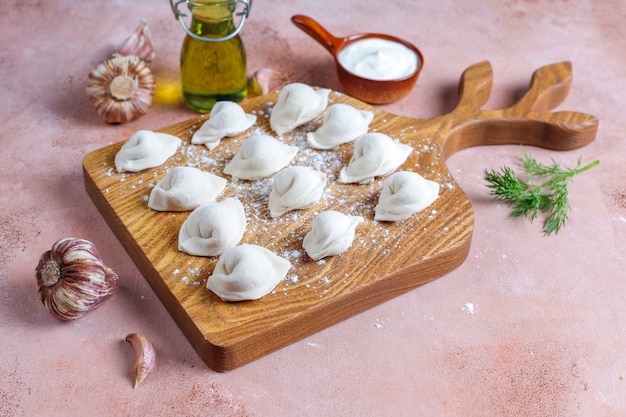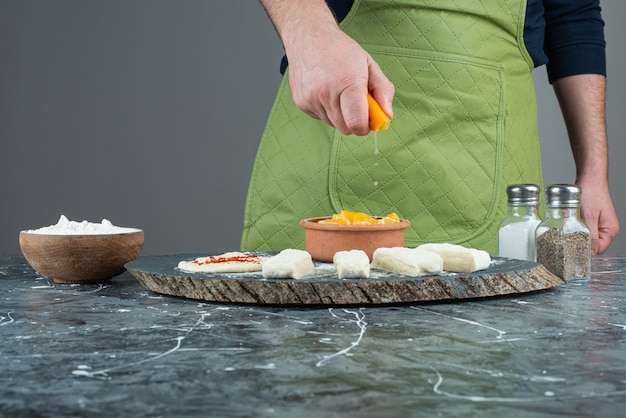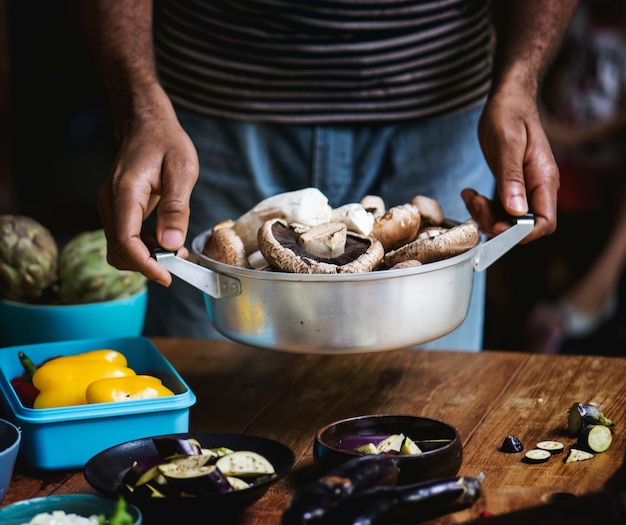You've got a bag of beautiful bay scallops, and you're eager to transform them into a culinary masterpiece. But before you dive in, let's embark on a journey into the world of scallop cooking. This isn't just about recipes; it's about understanding these delicate treasures and mastering the art of bringing out their best.
(Part 1) Meet Your Scallops: A Brief Introduction

Don't underestimate the humble scallop. Bay scallops, in particular, are a culinary treasure. They are tiny, sweet, and possess a texture that melts in your mouth, unlike the larger, chewier varieties often found in restaurants. They're like little jewels – delicate and precious.
The name "bay scallop" gives us a clue to their origin. These little gems thrive in the clean, cool waters of bays along the Atlantic coast, stretching from Maine all the way down to Florida. This environment bestows upon them a unique, sweet flavor that sets them apart.
(Part 2) Getting Your Scallops Ready: Preparing for the Feast

With your fresh scallops in hand, it's time to prepare them for their starring role.
The Art of Cleaning Scallops
Cleaning scallops isn't as daunting as it sounds. First, give them a thorough rinse under cold running water. Then, check for any lingering pieces of shell or sand. You can gently rub them between your fingers to remove these impurities. If needed, use a small, sharp knife to carefully remove any remaining shell fragments.
Drying Those Little Gems
Scallops need to be thoroughly dry before hitting the pan. Why? Because when heated, they release their natural moisture. We want them to sear, creating a beautiful golden-brown crust, not steam. Pat them dry with paper towels to ensure optimal results.
The Salt and Pepper Dance
Before the sizzle, give your scallops a light sprinkle of salt and pepper. Don't overdo it; we're simply enhancing their natural sweetness. Remember, less is more.
(Part 3) searing scallops: The Golden Rule

Searing is the key to unlocking the full potential of bay scallops. We're aiming for a gorgeous, caramelized crust that will tantalize your taste buds.
The Right Pan
Choose a pan that heats quickly and distributes heat evenly. Cast iron is a classic choice, but a high-quality stainless steel pan will also work well.
The Hot Hot Heat
Heat the pan over high heat until it's smoking hot. You want to hear a gentle sizzle when the scallops hit the pan.
The One-Minute Tango
Carefully place the scallops in the pan, one at a time, and sear for about a minute per side. Resist the urge to move them around too much; let the crust develop undisturbed. If cooking a large batch, avoid overcrowding the pan, as this will lower the temperature and prevent proper searing.
The doneness test
How do you know they're cooked? The edges will turn a beautiful golden brown, and the centers will become opaque, no longer translucent. A quick glance at the edges will reveal their readiness.
(Part 4) cooking time: Beyond the Sizzle
You've achieved those glorious seared scallops; now it's time to explore different cooking methods.
The Pan-Seared Delight
The pan-seared method is a classic for a reason. It's quick, easy, and delivers a simple yet elegant result. Simply sear the scallops until they're golden brown and cooked through.
The Oven-Roasted Journey
For a more sophisticated approach, try oven-roasting. Toss the scallops in olive oil, herbs, and lemon juice, then roast them in a hot oven for about 5-7 minutes. This method creates a slightly firmer, tender texture.
The Stir-Fry Adventure
For a vibrant and flavorful experience, stir-fry your scallops with your favorite vegetables and sauce. The heat quickly cooks the scallops and allows the flavors to meld.
(Part 5) Flavor Explosions: Sauces and Seasonings
With your scallops perfectly cooked, it's time to enhance their flavor. This is where your culinary creativity takes flight.
Butter is Your Friend
Let's face it – butter makes everything better, including scallops. As they're searing, add a knob of butter to the pan. Let it melt and spoon it over those golden beauties.
The Herby Twist
Fresh herbs are the secret weapon in many scallop dishes. Explore thyme, rosemary, parsley, chives, basil, or any herb that suits your palate. Add them towards the end of cooking to unleash their aromatic essence.
Citrus Burst
A squeeze of lemon or lime juice adds a bright and refreshing touch. Drizzle it over the scallops just before serving or incorporate it during cooking.
The Spice Factor
Don't shy away from adding a touch of spice. A pinch of red pepper flakes, a sprinkle of cayenne, or a drizzle of chili oil can elevate your dish to new heights.
(Part 6) Serving Style: A Culinary Showcase
Your scallops are ready to shine; now it's time to present them in a way that enhances their culinary appeal.
The Classic Plate
A simple and elegant approach involves serving your scallops on a bed of creamy polenta or mashed potatoes. Garnish with chopped parsley or a drizzle of olive oil for a finishing touch.
The Pasta Party
Toss those scallops into your favorite pasta dish for a luxurious upgrade. They pair beautifully with simple garlic and olive oil sauce or a creamy pesto.
The Salad Sensation
For a lighter option, add scallops to a salad. They complement greens, citrus fruits, and nuts perfectly.
(Part 7) scallop recipes: A Taste of Heaven
Let's dive into some delectable scallop recipes that will tantalize your taste buds.
pan-seared scallops with Lemon Butter Sauce
Ingredients:
- 1 pound bay scallops, cleaned and patted dry
- 2 tablespoons olive oil
- 1/4 cup unsalted butter
- 2 cloves garlic, minced
- 1/4 cup dry white wine
- 2 tablespoons lemon juice
- Salt and pepper to taste
- Fresh parsley, chopped for garnish
Instructions:
- Heat the olive oil in a large skillet over medium-high heat.
- Add the scallops and cook for 1 minute per side, or until golden brown and cooked through.
- Remove the scallops from the skillet and set aside.
- Add the butter to the skillet and melt over medium heat.
- Add the garlic and cook for 30 seconds, or until fragrant.
- Add the white wine and lemon juice, and bring to a simmer.
- Cook for 1 minute, or until the sauce has thickened slightly.
- Season with salt and pepper.
- Return the scallops to the skillet and toss to coat in the sauce.
- Serve immediately, garnished with fresh parsley.
Oven-roasted scallops with Garlic Herb Butter
Ingredients:
- 1 pound bay scallops, cleaned and patted dry
- 2 tablespoons olive oil
- 2 cloves garlic, minced
- 1 tablespoon chopped fresh herbs (such as thyme, rosemary, or parsley)
- 1/4 cup unsalted butter, softened
- Salt and pepper to taste
Instructions:
- Preheat oven to 400 degrees Fahrenheit.
- In a large bowl, combine the scallops, olive oil, garlic, herbs, and butter.
- Season with salt and pepper.
- Spread the scallops in a single layer on a baking sheet.
- Roast for 5-7 minutes, or until cooked through and golden brown.
- Serve immediately.
Spicy Stir-Fried Scallops with Vegetables
Ingredients:
- 1 pound bay scallops, cleaned and patted dry
- 2 tablespoons olive oil
- 1 cup chopped vegetables (such as broccoli, carrots, snap peas, or bell peppers)
- 1/4 cup soy sauce
- 1 tablespoon honey
- 1 teaspoon sesame oil
- 1/2 teaspoon red pepper flakes
- Salt and pepper to taste
- Sesame seeds, for garnish
Instructions:
- Heat the olive oil in a large skillet or wok over medium-high heat.
- Add the vegetables and cook for 3-5 minutes, or until tender-crisp.
- Add the scallops and cook for 2-3 minutes, or until cooked through.
- In a small bowl, whisk together the soy sauce, honey, sesame oil, and red pepper flakes.
- Pour the sauce over the scallops and vegetables and cook for 1 minute, or until the sauce has thickened.
- Season with salt and pepper.
- Serve immediately, garnished with sesame seeds.
(Part 8) Beyond the Plate: scallop storage and Sustainability
Now that we've explored the art of cooking and serving, let's delve into the practicalities of keeping those scallops fresh until they're ready to be enjoyed.
Storage Strategies
Fresh bay scallops are best enjoyed the day they're purchased. If you need to store them, wrap them tightly in plastic wrap and refrigerate them for up to one day. Ensure they remain cold, below 40 degrees Fahrenheit.
Sustainable Seafood: Making the Right Choice
Sustainability is crucial when it comes to seafood. When selecting scallops, look for labels that indicate responsible harvesting practices. The Marine Stewardship Council (MSC) label is a reliable indicator that the scallops have been caught in a way that protects the environment and future generations.
(Part 9) FAQ: Your Scallop Questions Answered
Here are some answers to common questions about these culinary gems:
1. How Do I Tell if Scallops Are Fresh?
Fresh bay scallops should have a sweet, slightly briny aroma. They should also be firm to the touch, not mushy or slimy. Any discoloration is a sign that they may not be as fresh.
2. What's the Difference Between Bay Scallops and sea scallops?
Bay scallops are smaller and sweeter than sea scallops. They also have a more delicate texture, offering a melt-in-your-mouth experience. Sea scallops are larger and have a firmer texture.
3. How Long Should I Cook Scallops?
Cooking time for scallops varies depending on the method used. Pan-searing takes about 1 minute per side. Oven-roasting requires 5-7 minutes, while stir-frying takes 2-3 minutes.
4. Can I Freeze Scallops?
While you can freeze bay scallops, it's best to freeze them raw. Spread them out on a baking sheet in a single layer and freeze for 30 minutes. Then, transfer them to a freezer bag and freeze for up to 3 months.
5. Can I Eat Scallop Shells?
No, scallop shells are not edible. The edible portion is the muscle attached to the shell.
(Part 10) The Final Bite: A Passion for Scallops
There you have it, a comprehensive guide to cooking bay scallops. I hope you've gained valuable insights and are inspired to create culinary magic in your kitchen. These little gems deserve to be cherished and celebrated.
Remember, if you have any questions, don't hesitate to ask. I'm always happy to share my passion for scallops and help you create delicious meals. Happy cooking!
Everyone is watching

How to Cook Frozen Lobster Tails Perfectly: A Step-by-Step Guide
RecipesLobster. Just the word conjures up images of lavish meals, special occasions, and a taste of luxury. But let's...

Pigs in a Blanket Cooking Time: How Long to Bake for Perfect Results
RecipesAh, pigs in a blanket. Just the name conjures up images of those delightful little parcels of crispy pastry en...

Pork Fillet Cooking Time: How Long to Cook It Perfectly
RecipesPork fillet, or tenderloin as it's sometimes called, is a real favourite in our house. It's so versatile, and...

The Ultimate Guide to Tender, Juicy Pulled Pork
RecipesRight, let's talk pulled pork. It's one of those dishes that just screams "comfort food," doesn't it? I mean...

The Ultimate Guide to Cooking Delicious Frankfurters
RecipesLet's face it, we all love a good frankfurter. It's a classic, simple, and always satisfying. But let's be rea...
